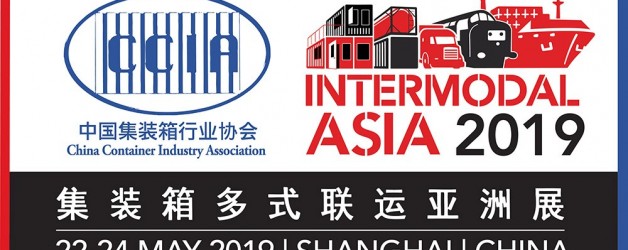INTERMODAL ASIA 2019, One Belt One Road Forum
TRIESTE, TERRITORY AND FREE PORT TERMINUS OF THE SILK ROAD: THE UNRESOLVED QUESTION AT THE DOOR OF THE CENTRAL EUROPE
Shanghai, 23 May 2019
Below the speech of TRIEST NGO
TRIEST is a non-governmental organization founded in April 2013 in London. It is a non-profit organization, financed by free donations and made of citizens who carry out their work free of charge.
The aim of TRIEST NGO is to bring awareness and sensitize international organizations, governments and citizens, and more generally all stakeholders interested in the issue of the Free Territory of Trieste (FTT), of its international Free Port and in the respect for Human Rights for the citizens of this Territory.
The main activity of TRIEST NGO is to report the total non-fulfillment of the current international laws that determine the existence of the Free Territory of Trieste and the violation of the Right to Development for the citizens of this Territory. The organization carries out its actions primarily by restoring the historical truth on the Free Territory of Trieste, making it known locally and internationally and denouncing the violations of Human Rights suffered by its citizens. The laws in force for the Territory have been, and still are, denied, falsified, ignored and manipulated by the States that have always had economic, political and military interests in this area.
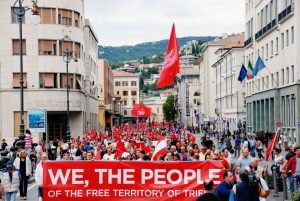
Since 2011 to date, the citizens of the Free Territory of Trieste have gradually reorganized themselves spontaneously, giving rise to movements and organizations aimed at asserting their rights peacefully and decisively.
TRIEST NGO collects and represents the hopes of these citizens for a better future, where the 1947 Peace Treaty and their Rights are respected and when the specific development potential, proper of this Territory, mainly the international Free Port of Trieste and its Free Zones, is fully carried out, thus effectively leading to a collective and individual well-being.
Today TRIEST NGO is here to define the Free Territory of Trieste Issue and explain the potential of its Free Port inserted in the context of the Maritime Silk Road.
Trieste was the main port of the Austro-Hungarian Empire, from 18 March 1719, thanks to the proclamation as a free port of the Emperor Charles VI of Habsburg. From then on, Trieste experienced an unstoppable flourishing period, becoming in a few words in the Austro-Hungarian Empire, together with Vienna, Budapest and Prague, the cultural, economic and financial reference for all of central Europe. The immense warehouses of the North Free Zone were the grain stores for Austria and Bavaria, and every type of activity thrived there. All this ended with the first invasion of Italy in 1918. Trieste annexed to Italy lost its vast natural hinterland to become an insignificant port located at the extreme eastern periphery of a state of which it has never been a part.
The international free port of Trieste, located in the heart of Europe is today a Free Port defined by Annex VIII of the Paris Peace Treaty of 1947 and intended as an economic instrument of the Free Territory of Trieste, designed for it and the States of the center Europe and the Balkan/Danubian area. To better understand the issue it is necessary to present a brief historical introduction.
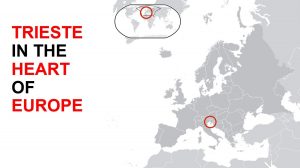
At the end of World War II, with Resolution 16 of 10 January 1947 the United Nations Security Council defined the existence of the Free Territory of Trieste, and the Paris Peace Treaty of 10 February 1947 confirmed the legislative aspects of a sovereign, neutral and demilitarized State. The Peace Treaty entered into force on September 15 of the same year. It cannot be modified, it can only be implemented, and it is still in force and has been incorporated into Italian legislation since 1947.
The Free Territory was approved and acknowledged together with its three instruments and annexes as integral part of the Treaty of Peace itself. These are: 1) the Permanent Statute for the Free Territory of Trieste (Annex VI); 2) the Instrument for the Provisional Regime of the Free Territory of Trieste (Annex VII); 3) the Instrument for the Free Port of Trieste (Annex VIII).
The Free Territory of Trieste was – and still is – defined by articles 4, 21, 22 and by Annexes VI, VII, VIII of the Treaty of Peace. Article 21 of the Treaty of Peace states that:
There is hereby constituted the Free Territory of Trieste, consisting of the area lying between the Adriatic Sea and the boundaries defined in Articles 4 and 22 of the present Treaty. The Free Territory of Trieste is recognized by the Allied and Associated Powers and by Italy, which agree that its integrity and independence shall be assured by the Security Council of the United Nations. Italian sovereignty over the area constituting the Free Territory of Trieste, as above defined, shall be terminated upon the coming into force of the present Treaty.”
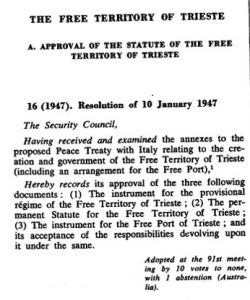
The UN Security Council in Resolution 16 accepted and assumed responsibility for the integrity and independence of the Free Territory of Trieste, a condition conclusively sanctioned in the Treaty of Peace. The administration of the FTT was provisionally entrusted to the two military occupation zones until the appointment of the Governor, respectively: “Zone A”, Trieste together with its Port, to the Anglo-American military Government, and “Zone B” to the Yugoslav military government.
In 1954, unable to find an agreement within the UN Security Council on the appointment of the Governor – deliberately boycotted – the Governments (not the States) of the United Kingdom, the United States of America, Yugoslavia and Italy initialed the Memorandum of Understanding of London on 5 October 1954. On October 26 the Anglo-American armed forces left Trieste and the Italian Army entered the “demilitarized” zone A. The Memorandum, not being a treaty, had to outline the intent of a handover from military to civil administration and not obviously a change of sovereignty.
As a matter of fact, the 1954 Memorandum of Understanding of London, was a letter of intent without the binding and normative characteristic of the treaties, such as that of Peace of Paris in 1947 which could not be amended. The Memorandum served only at the time as political tool to deceive public opinion about its real goal, that is to say to first occupy and then illegally annex the Free Territory of Trieste – divided between Italy and Yugoslavia in violation of international law – thanks also to the deafening silence of the international community and the United Nations, whom had assumed the responsibility of ensuring instead its integrity and independence.
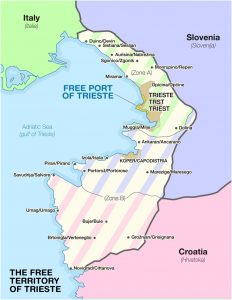
The Free Territory of Trieste, TODAY
The citizens have been deprived not only of their legitimate Citizenship of the Free Territory of Trieste, as defined by Article 6 of Annex VI of the Peace Treaty, therefore of all civil and political rights as citizens of this Territory, and they were also denied the Right to Development, an inalienable human right. In fact, the development of the Free Port of Trieste, as the main resource of the Territory, was prevented and the economy of the city and surrounding areas blocked.
To date, Annex VIII – Instrument for the Free Port of Trieste – has not yet been applied by the Italian Government. This default has caused a profound economic, occupational and social crisis, which has gradually become worse over time.
Today, not only Trieste could benefit from the advantages deriving from the development of the international free port but also those countries that had always had Trieste as their natural geographical point of reference, in addition to all the States of the world, which intend to develop economic relations with central Europe.
The Free Port of Trieste is located in the center/south of Europe, set in the extreme north-eastern spur of the Mediterranean sea. The depths of the port of Trieste vary between 14 and 22 meters, and allows mooring to any ship that crosses the Suez Canal. It is divided into two areas: the “New Port” and the “Old Port”, both measuring over 65 hectares and connected from each other by the so-called “belt line”, a modern underground railway line passing under the urban area of Trieste, now UNUSED.
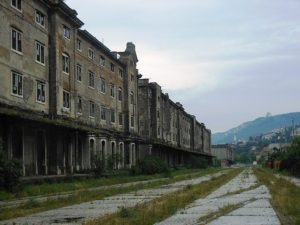
An eloquent image of the total abandonment and destruction of the North Free Zone caused by Italy
Italy today, despite not having de jure sovereignty over the port of Trieste, is attempting to urbanize the area of the Old Port thus illegally taking it away from the state property of the FTT and the international community, being the Free Port placed under the aegis of the UN Security Council. Italy would like to transform this vast free zone area in museum, tourist, cruise, congress and/or urban center. All except for the real productive and business activities for which it was intended.
The Free Port of Trieste includes five specific free zones: the North Zone (so-called Old Port) transposition of the Austrian market town, where over seventy branches of activity can be carried out, including insurance and financial banking, the other free zones are for oil, timber and industrial settlements in extraterritorial and non-EU conditions. From the SIOT entrance of the free port of Trieste part of the oil pipeline to Germany to cover 30% of German energy needs.
In these free zones, in addition to the primary activity concerning container traffic, Annex VIII foresees, above all, the emporium activity, the transformation of goods into an extra-customs and extraterritorial regime. It is potentially an incalculable source of wealth and development, however, a condition that exists only on paper, unrealized today due to the Italian boycott carried out in the first place with the imposition of the unsurpassable barrier against the Italian bureaucratic system and Italian taxes.
The legal bases of the Free Port of Trieste today, are the following:
- Treaty of Peace with Italy signed in Paris on 10 February 1947 with Annexes (Articles 4, 21, 22, 85; Annexes VI, VII, VIII)
- UN Security Council Resolution 16 (S/RES/16) of 10 January 1947;
The Free Port of Trieste is indivisible from the Free Territory of Trieste, both are interconnected. The Annex VIII states that the “Free Port shall be established and administered as a State corporation of the Free Territory” (Annex VIII, article 2) and that it must be administered by an “International commission“, composed of several States.
Furthermore, that “the establishment of special areas in the Free Port under the exclusive jurisdiction of any State is incompatible with the status of the Free Territory and of the Free Port” (Annex VIII, article 3) as instead happens now under that of the Italian State, a State – let’s remember – has no sovereignty over it. An important fact is also that the port of Trieste is – de jure – not only an international area but also an extra-European area.
TRIEST NGO intends to establish an “International Commission of the Free Port” (Annex VIII, article 21 and following), the only subject capable to adequately develop the Port and its Free Zones, in the primary interest of its Population as well as of the populations of the States of the Balkan/Danube area, but more generally of all the States of the world.
The de facto application of Annex VIII will definitely determine the development of the Free Port of Trieste, with a consequent strong increase in employment and relative improvement of the economic and social conditions of the population, as it happens in all the Free Zones worldwide.
The development of the Free Port of Trieste is closely connected also to civil and political rights, related to the Right to Citizenship, through the establishment of the Popular Assembly, made up of citizens of the Free Territory of Trieste, holders of the responsibility, as well as the right, for the development of the Territory. Until today, this natural state of affairs is totally denied and is controlled exclusively by the Italian State, which is also the exclusive and direct beneficiary of its revenues.
These two apparently separate documents are actually deeply interconnected: Annex VIII is the practical economic instrument for the development of the Free Territory of Trieste and the UN Declaration on the Right to Development (Resolution of the General Assembly of the United Nations A/RES/41/128 of 04.12.1986) provides instead the policy through which this tool must be finalized.
In fact, Annex VIII does not exclusively and limitedly concern the Free Port of Trieste as such, but it is the main “natural” resource available to the Territory and which was conceived for the FTT. Certainly not for the exclusive benefit of Rome, that is, of another State.
This resource must be developed for the purpose of obtaining the collective and individual well-being, not only of Trieste, together with respect for all human rights and fundamental freedoms.
According to the provisions of the UN Declaration on the Right to Development:
The right to development is an inalienable human right by virtue of which every human person and all peoples are entitled to participate in, contribute to, and enjoy economic, social, cultural and political development, in which all human rights and fundamental freedoms can be fully realized. The human right to development also implies the full realization of the right of peoples to self-determination, which includes, subject to the relevant provisions of both International Covenants on Human Rights, the exercise of their inalienable right to full sovereignty over all their natural wealth and resources.”
It is clear that the development of the international Free Port of Trieste must take place, as established, through the respect and application of all the rights of the citizens of this Territory. Only in this way, the economic and consequently social benefits deriving from the application of Annex VIII can be oriented to the advantage of this Territory and its inhabitants and of all the States that intend to benefit from its unique legal status in the heart of the Europe: free zone, international and non-EU.
Certainly the use of the international free port of Trieste inserted in the Belt and Road Initiative (BRI), would bring benefit and development to the international community.
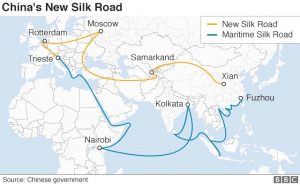
On March 23, 2019, the Italian government and the President Xi Jinping signed the Memorandum of Understanding “on cooperation within the framework of the Silk Road Economic Belt and the 21st Century Maritime Silk Road”. According to this Memorandum the Parties have committed themselves to the promotion of sustainable development and the provisions of the “Declaration on the Right to Development” should be considered the guideline on how to achieve it.
The Parties intend to respect the laws in compliance with international obligations, to which the Paris Peace Treaty of 1947 is the legal basis of the international Free Port together with the Free Territory of Trieste, as well as the observance of the aims and principles expressed in the Charter of United Nations, which in its preamble states:
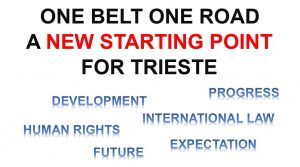
“We the peoples of the United Nations, determined […] to reaffirm faith in fundamental human rights, in the dignity and worth of the human person, in the equal rights of men and women and of nations large and small, and to establish conditions under which justice and respect for the obligations arising from treaties and other sources of international law can be maintained, and to promote social progress and better standards of life in larger freedom”
We hope that this could be today, the starting point from which to start and build a future of prosperity and development for Trieste, but also the win-win solution for all the States that intend to be part of the Belt and Road Initiative and benefit from this great project.
We of TRIEST NGO, as citizens of Trieste and spokesman of the aspirations of development of our city and of the hopes of our people, trust in this.

Author: Alessia Goiach
Speaker: Alessandro Gombac
This page is also available in: Italian

 newsletter
newsletter
 contact us
contact us
 donations
donations